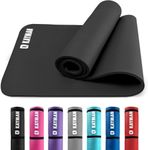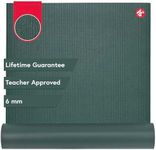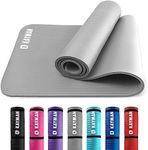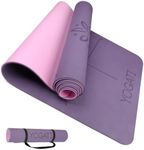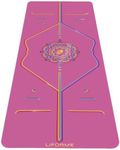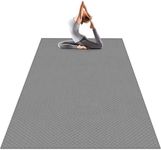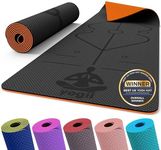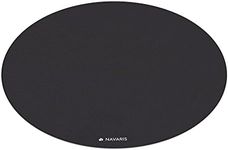Buying Guide for the Best Yoga Mats
Choosing the right yoga mat is essential for a comfortable and effective practice. A good yoga mat provides the right amount of cushioning, grip, and stability, enhancing your overall experience. When selecting a yoga mat, consider your personal needs, the type of yoga you practice, and where you will be using it. Different mats offer various features, so understanding these can help you make an informed decision that aligns with your practice and lifestyle.MaterialThe material of a yoga mat affects its texture, stickiness, eco-friendliness, and durability. Common materials include PVC, TPE, natural rubber, and cork. PVC mats are durable and provide good grip but are not eco-friendly. TPE mats are lightweight and more environmentally friendly. Natural rubber mats offer excellent grip and are biodegradable, but they can be heavy. Cork mats are naturally antimicrobial and provide a unique texture. Consider your values and needs, such as whether you prioritize sustainability or need a mat with a specific texture or grip.
ThicknessThickness determines the level of cushioning and support a yoga mat provides. Standard mats are about 1/8 inch thick, offering a balance of comfort and stability. Thicker mats, around 1/4 inch, provide more cushioning, which is beneficial for sensitive joints or restorative practices. Thinner mats, like travel mats, are about 1/16 inch thick and are more portable but offer less cushioning. Choose a thickness based on your comfort preference, the type of yoga you practice, and whether you need to transport the mat frequently.
TextureTexture affects the mat's grip and how it feels under your hands and feet. A textured mat can prevent slipping, which is important for vigorous practices like Ashtanga or hot yoga. Smooth mats may feel more comfortable for slower, meditative practices. Some materials naturally have more texture, like jute or rubber, while others, like PVC, can be manufactured with different textures. Consider how much grip you need and whether you prefer a smooth or textured surface.
StickinessStickiness refers to how well the mat stays in place on the floor and how well it prevents your hands and feet from slipping during poses. A sticky mat helps maintain alignment and stability, especially in standing poses. PVC mats are known for their stickiness, while natural materials may offer less. If you practice dynamic styles of yoga, a sticky mat can be beneficial. Consider how much you move during your practice and whether you need extra help staying in place.
SizeMost yoga mats are about 68 inches long and 24 inches wide, which suits most people. However, if you're taller, you might need a longer mat to ensure your entire body fits during poses. Wider mats can provide more space for movement. Consider your height and the space you need for your practice. If you often find yourself off the mat during poses, a larger size might be more comfortable.
PortabilityPortability is important if you plan to carry your mat to classes or travel with it. Lightweight mats are easier to transport but may offer less cushioning. Some mats come with carrying straps or bags, which can be convenient. Consider how often you'll need to move your mat and whether you need features that make it easier to carry.


